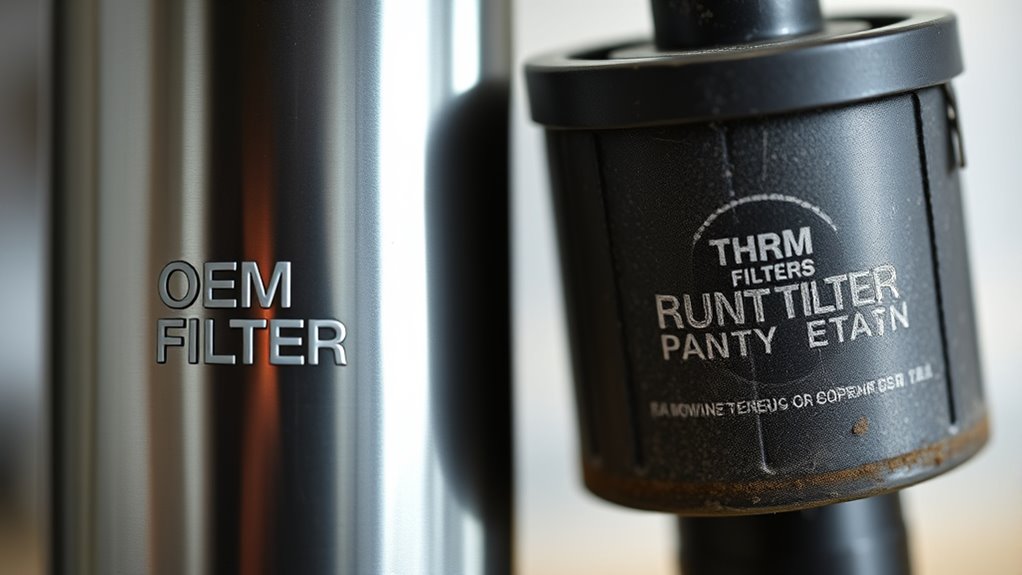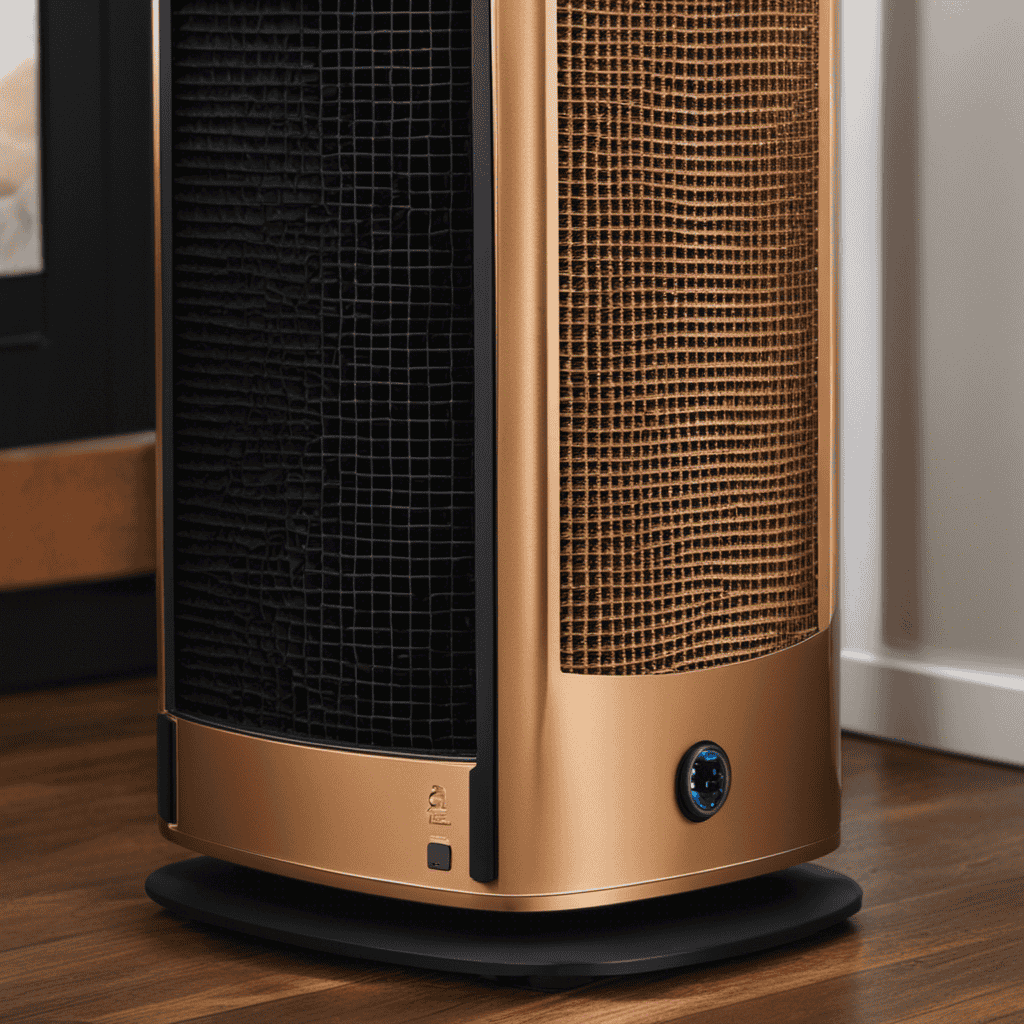Choosing between OEM and third-party filters depends on your budget, performance expectations, and vehicle needs. OEM filters fit perfectly, meet original standards, and often last longer, offering reliable protection. Off-brand filters can be cheaper and environmentally friendly but may vary in quality and fit. To guarantee your system runs smoothly and lasts longer, it is crucial to weigh the risks and benefits carefully. If you’re interested in making the best choice, there’s more to consider as you continue.
Key Takeaways
- OEM filters are designed for perfect fit and reliability, reducing risks of leaks and system damage.
- Third-party filters can be cost-effective but may vary in quality and compatibility, affecting performance.
- OEM filters typically offer longer lifespan and consistent filtration, supporting vehicle longevity.
- Reputable third-party brands can match OEM standards at a lower price, but verify certifications and reviews.
- Consider environmental impact and your budget to balance cost, quality, and sustainability when choosing filters.
Understanding the Role of Filters in Your Vehicle and HVAC Systems
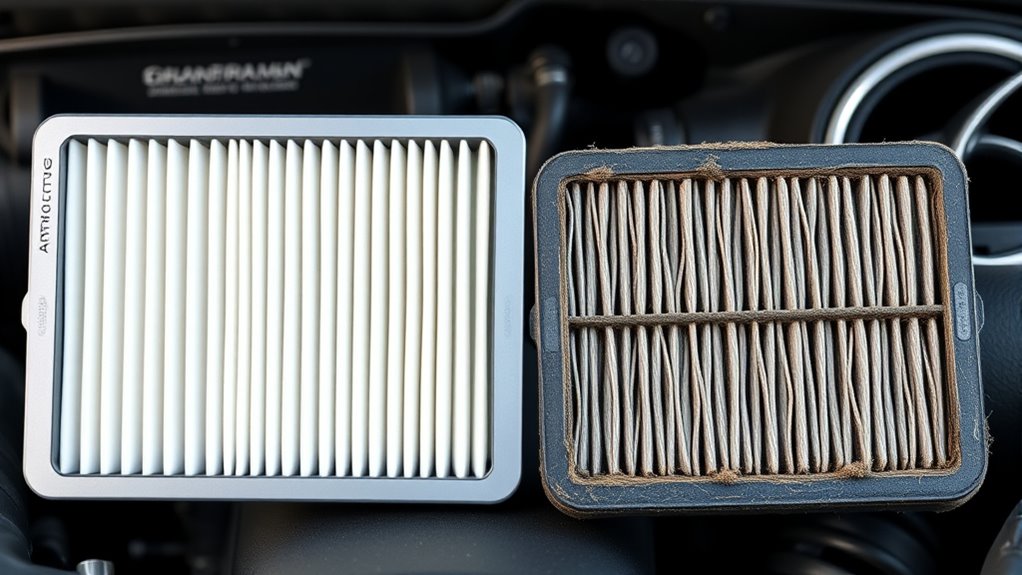
Filters play a crucial role in keeping your vehicle and HVAC systems running smoothly by trapping dust, debris, and pollutants. When filters work effectively, they improve your air quality by preventing harmful particles from circulating indoors or inside your vehicle. This not only creates a healthier environment but also helps maintain system efficiency. A clean filter allows airflow to move freely, reducing strain on your HVAC system or engine, which can save you money on energy or repair costs. Regularly checking and replacing filters ensures ideal air quality and keeps your systems running efficiently, preventing unnecessary wear and tear. Additionally, understanding the importance of air purification can help you choose the right filters and maintenance practices to enhance your indoor and vehicle air quality. Proper filter maintenance is essential for prolonging the lifespan of your systems and ensuring they operate at peak performance, as filter quality directly impacts their effectiveness. Staying informed about filter lifespan and replacement intervals can further optimize your system’s health and efficiency, especially when considering the impact of filter upgrades on overall performance.
What Are OEM Filters and Why Do They Matter?
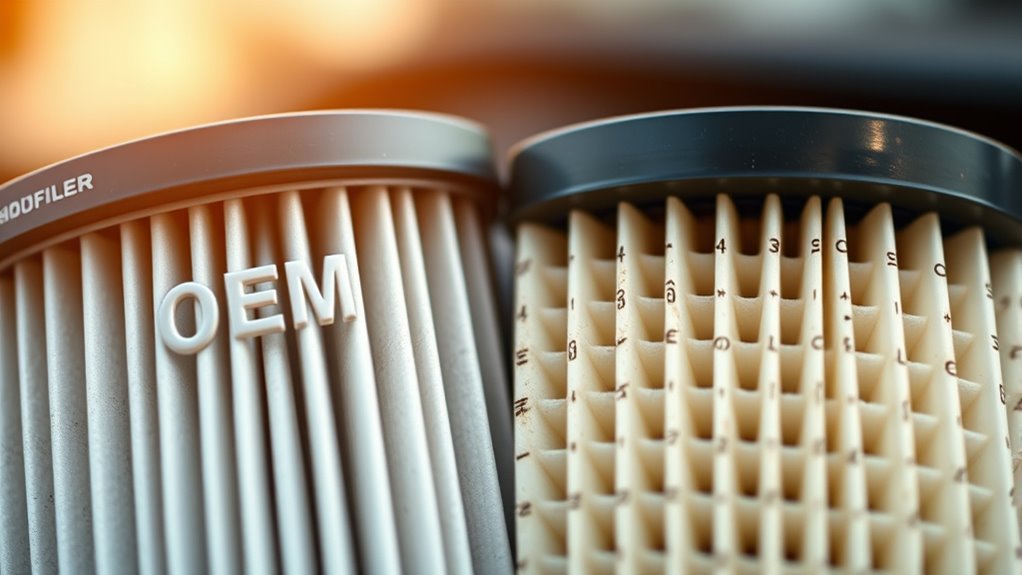
OEM filters, or Original Equipment Manufacturer filters, are specifically designed and produced by your vehicle or HVAC system’s manufacturer to match the original specifications. They are engineered to fit perfectly and perform reliably, which can influence the filter lifespan and overall system efficiency. Because they come from the same brand that built your equipment, they typically uphold the original quality standards, supporting your system’s longevity. Brand reputation plays a significant role, as OEM filters are trusted for consistent performance and durability. Using OEM filters guarantees you’re maintaining the system as intended, reducing the risk of premature wear or failure. While they may cost more upfront, their proven quality can save you money on repairs and replacements in the long run.
Exploring Third-Party and Off-Brand Filter Options
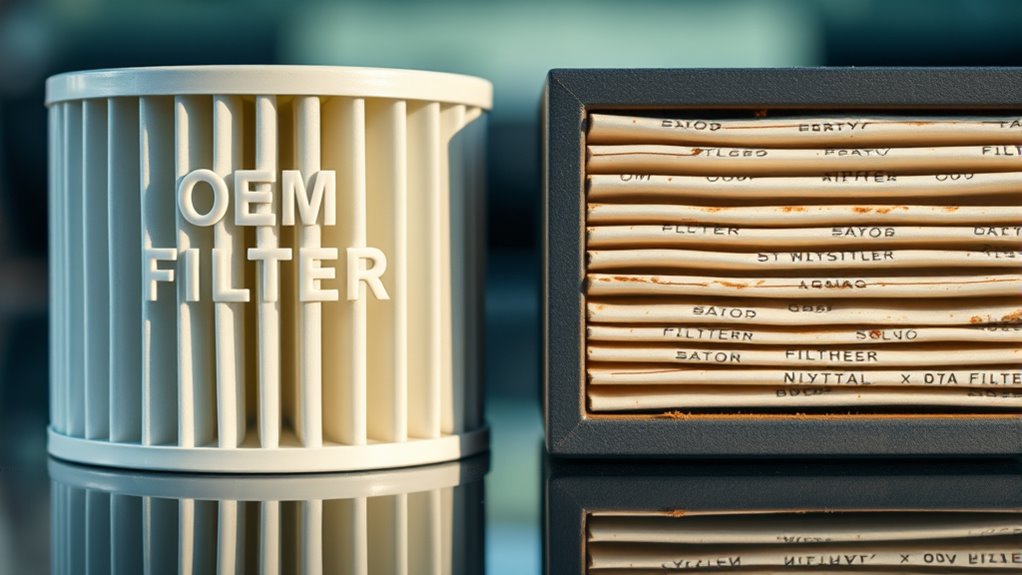
Third-party filters often come with a lower price tag, making them an attractive option for budget-conscious shoppers. However, you should consider how their compatibility and quality compare to OEM filters to guarantee you’re not sacrificing performance. Balancing cost-effectiveness with reliability is key when exploring off-brand filter choices. Additionally, researching lifevest advisors can help you identify reputable brands and avoid potential scams or subpar products. It’s also helpful to understand the filter material quality in ensuring optimal filtration and longevity. Choosing filters made from high-quality materials can significantly impact both the filtration efficiency and the lifespan of the replacement. Being aware of filter weight can assist in easier handling and installation, especially for larger models. Furthermore, understanding the core personality traits of reputable brands can guide you toward more trustworthy options.
Cost-Effectiveness Factors
While OEM filters often come with a higher price tag, exploring third-party and off-brand options can substantially reduce costs. You might save money upfront, but consider the brand reputation behind these filters—some deliver reliable performance, while others may compromise quality. Off-brand filters often have a lower environmental impact due to sustainable manufacturing practices, which appeals to eco-conscious consumers. Additionally, cheaper options sometimes sacrifice filtration efficiency, risking potential damage to your system. Balancing cost and quality is key. Moreover, understanding the contrast ratio of your projector can help you select filters that maintain optimal image clarity and contrast. It’s also important to evaluate the certifications and standards of third-party filters to ensure they meet safety and quality benchmarks. Incorporating quality assurance processes can further help verify that the filters meet industry expectations for performance and durability. Being aware of potential performance variability among different brands can also guide you toward more consistent results.
Compatibility and Quality
Choosing the right filter requires careful attention to compatibility and quality. Off-brand filters can vary widely in how well they fit and perform, affecting your filter lifespan and system efficiency. To assess third-party options, consider these factors:
- Compatibility: Ensure the filter matches your system’s specifications to avoid leaks or damage.
- Filter Lifespan: Check reviews for consistency in how long the filter lasts before needing replacement.
- Brand Reputation: Trust brands with a proven track record for quality and customer satisfaction, which often correlates with better durability and filtration performance.
Comparing Quality and Performance: OEM vs. Third-Party Filters

When evaluating filters, understanding the differences in quality and performance between OEM and third-party options is essential. OEM filters typically have a longer filter lifespan because they meet the manufacturer’s strict standards, ensuring consistent performance. They often come from brands with a strong reputation for quality, which gives you confidence in their durability and effectiveness. Third-party filters can vary widely in quality; some may match OEM standards, while others fall short, leading to reduced filter lifespan and compromised performance. It’s important to research the brand reputation of third-party options before purchasing. This is especially relevant when considering product quality standards, which can significantly impact the overall reliability of your filters. Additionally, third-party filters that do not adhere to recognized standards may lack the necessary certifications, increasing the risk of subpar performance. For example, filter lifespan can be affected by the materials used and adherence to industry standards, emphasizing the importance of choosing reputable brands. The performance consistency of a filter is another crucial factor, as inconsistent filtration can lead to system issues or decreased efficiency. Proper filter maintenance is also crucial to maximize the lifespan and effectiveness of your chosen filter. Ultimately, choosing between OEM and third-party filters depends on your priorities for reliability and longevity, but knowing these differences helps you make an informed decision.
Cost Implications and Budget Considerations
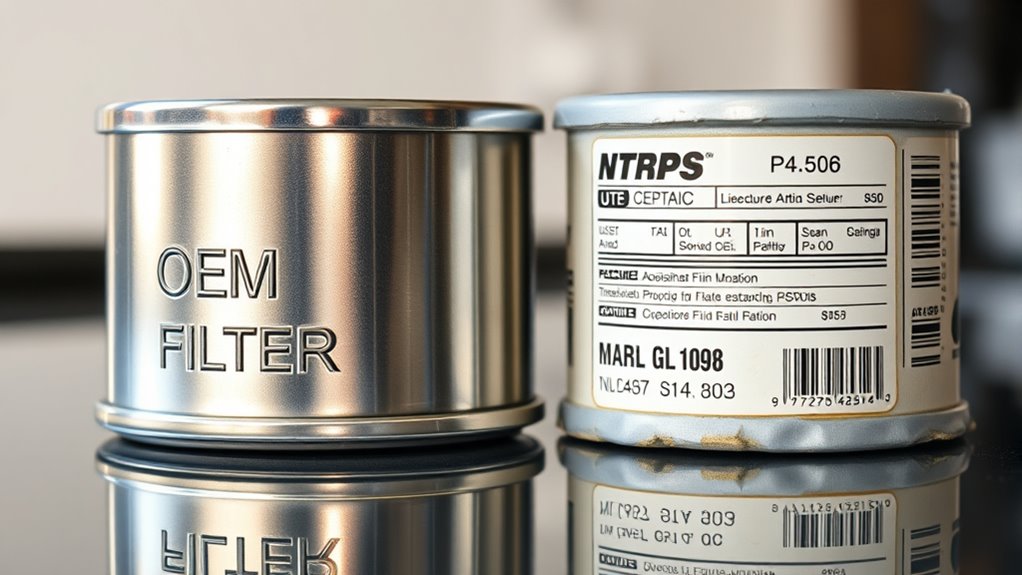
When choosing between OEM and third-party filters, cost is a key factor to contemplate. You’ll find that third-party options often come with lower upfront prices, but long-term maintenance costs can vary. Understanding these price differences helps you make smarter budget decisions for your vehicle. Additionally, considering the quality of materials used in third-party filters can impact their durability and overall value. Opting for a filter material that meets safety standards ensures you’re not sacrificing performance for savings. Incorporating space optimization techniques into your maintenance routine can also help extend the lifespan of your filters and other components, ultimately saving money over time. Moreover, being aware of the cost implications associated with different filter options allows for more informed purchasing decisions. Selecting filters with proven performance improvements can further contribute to the overall health of your vehicle’s engine.
Price Differences and Savings
OEM filters typically come with a higher price tag compared to third-party options, which can substantially impact your maintenance budget over time. While the initial cost is higher, you might benefit from better brand reputation and warranty coverage that guarantees quality and reliability. To evaluate savings, consider these factors:
- The upfront cost difference between OEM and third-party filters.
- Potential savings from choosing off-brand options without sacrificing warranty coverage.
- The long-term value, considering quality and performance, which could reduce frequent replacements.
- Remember that digital literacy in modern education can influence how well children understand online safety, making it an important factor when selecting digital learning tools. Additionally, understanding the importance of product authenticity can help ensure you receive genuine, high-quality filters rather than counterfeit products. Ensuring proper exfoliation with reliable filters also contributes to better skin health and fewer skin issues. Being aware of emotional manipulation tactics used by counterfeit or subpar filters can save you from potential damage or ineffective performance. Although third-party filters may seem more affordable initially, verify if they meet your vehicle’s brand reputation standards. Balancing cost with warranty coverage and cost variances ensures you make an informed choice that aligns with your budget and peace of mind.
Long-term Maintenance Costs
Choosing between OEM and third-party filters can substantially impact your long-term maintenance costs, as the durability and performance of the filter influence how often you’ll need replacements. A higher-quality filter with a longer filter lifespan may cost more upfront but can save you money over time. Brand reputation plays a role here; trusted brands often produce filters that last longer and work more reliably, reducing replacement frequency. Conversely, lesser-known brands might be cheaper initially but could require more frequent changes, increasing costs. To help compare, consider this table:
| Filter Type | Average Filter Lifespan | Cost Implication |
|---|---|---|
| OEM (Brand-Name) | 12-15 months | Higher upfront, fewer replacements |
| Third-Party (Off-Brand) | 6-9 months | Lower initial cost, more frequent replacements |
| Budget Options | 3-6 months | Cheapest, but highest replacement costs |
Deciding wisely can help balance upfront savings with long-term budget needs. Additionally, the performance of a filter can influence overall device efficiency and longevity, making quality an essential factor in your decision.
Compatibility and Fitment Concerns
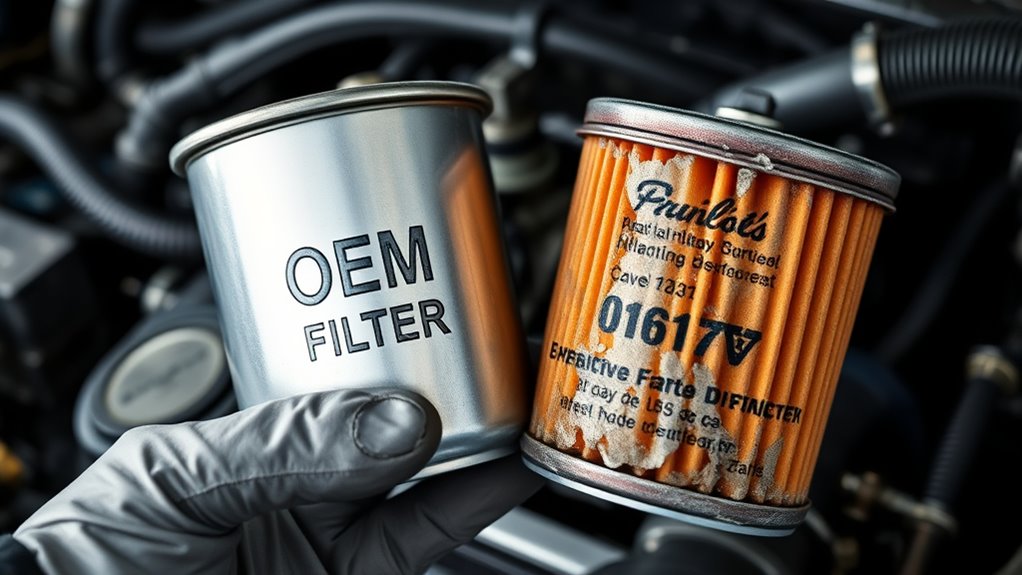
Although third-party filters often promise compatibility, they can sometimes pose fitment issues that OEM filters avoid. Poor fitment can lead to leaks, engine damage, or reduced performance, impacting your vehicle’s reliability. When considering off-brand options, keep in mind:
Third-party filters may fit poorly, risking leaks and engine issues; OEM filters ensure proper fit and reliability.
- Brand reputation: A lesser-known brand may cut corners, risking improper fitment.
- Warranty impact: Using incompatible filters could void your vehicle’s warranty if issues arise.
- Precision fit: OEM filters are designed specifically for your vehicle, ensuring perfect fitment and sealing.
Misfit filters might seem cost-effective initially but can cause long-term problems. Always verify compatibility and consider the potential warranty consequences before choosing an off-brand filter. Proper fitment is essential for maintaining your vehicle’s performance and protecting your investment.
Potential Risks and Benefits of Off-Brand Filters

Off-brand filters can offer some notable benefits, especially regarding cost savings and availability. They often use similar filter material to OEM filters, which can provide adequate filtration for everyday driving. However, the quality of the filter material varies between brands, so you might risk reduced filtration if the material isn’t up to standard. One potential risk is that off-brand filters may have a weaker build quality, leading to possible leaks or premature failure. Additionally, brand reputation matters—less reputable brands might cut corners to save costs, impacting performance and vehicle protection. On the flip side, some off-brand filters match OEM quality at a lower price. Weighing these risks and benefits helps you decide if an off-brand filter fits your maintenance needs and budget.
Making the Best Choice for Your Maintenance Needs
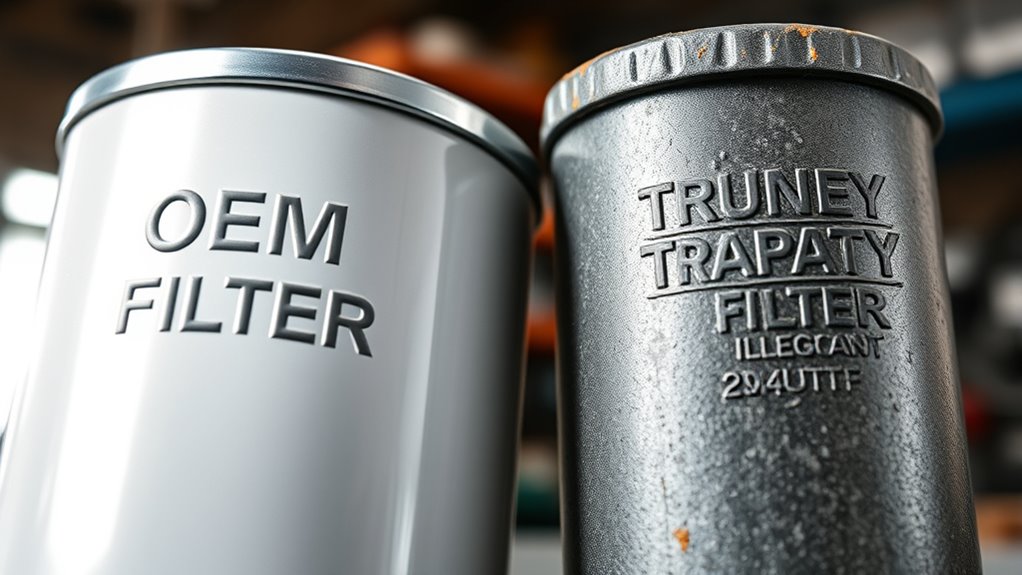
To make the best choice for your maintenance needs, consider balancing cost, quality, and your vehicle’s specific requirements. First, evaluate the brand reputation—reliable brands often ensure better performance and durability. Second, think about environmental impact; eco-friendly filters minimize waste and reduce pollution. Third, assess whether an OEM or third-party filter aligns with your budget without sacrificing essential quality. If you prioritize longevity and a trusted reputation, OEM filters may be the best choice. However, if affordability and environmental considerations matter most, certain third-party options can be suitable. Ultimately, your decision should reflect your vehicle’s needs and your values, guaranteeing you get ideal filtration while being mindful of environmental and financial factors.
Frequently Asked Questions
How Can I Tell if a Third-Party Filter Is Genuine?
To tell if a third-party filter is genuine, start by checking the brand reputation—reliable brands usually have positive reviews. Look for clear filter certification labels, which indicate it meets industry standards. Avoid filters with vague packaging or missing certification info. You can also verify authenticity by purchasing from authorized sellers or directly from the brand’s website. This way, you guarantee you’re getting a genuine, effective filter.
Do Third-Party Filters Void Vehicle Warranty?
You might wonder if using third-party filters affects your warranty. Coincidentally, most warranties don’t explicitly state that off-brand filters void coverage, but brand authenticity matters. If a third-party filter causes damage, warranty implications could come into play. To be safe, check your vehicle’s warranty terms and choose reputable brands. Using genuine parts minimizes risks and keeps your warranty intact, so don’t overlook the importance of authentic filters.
Are There Specific Brands Recommended for Third-Party Filters?
When choosing third-party filters, look for brands with proper certifications, ensuring they meet quality standards. Reputable brands often emphasize filter durability, giving you confidence that their products will last and protect your engine effectively. You should research customer reviews and verify certifications like ISO or SAE. These factors help you select reliable third-party filters that match or even surpass OEM performance, saving you money without sacrificing quality.
How Often Should I Replace Filters Regardless of Brand?
You should replace your filters regularly to maintain good air quality and system efficiency. Typically, the filter lifespan is about 1 to 3 months, but replacement frequency depends on factors like usage, allergies, and pets. Check your filter monthly; if it looks dirty or clogged, it’s time for a replacement. Staying on top of this routine helps ensure your HVAC runs smoothly and your indoor air stays clean.
Can Using Off-Brand Filters Improve My System’S Lifespan?
You might think off-brand filters could boost your system’s lifespan, but that’s ironic. While cheaper filter material might seem appealing, it often lacks durability and the brand reputation for quality matters more. Using subpar filters could cause more harm than good, leading to frequent replacements. Stick with trusted brands to protect your system, because a quality filter is an investment in longevity—not a shortcut.
Conclusion
Choosing between OEM and third-party filters is like picking the right tool for a job—you want something reliable yet affordable. While OEM filters offer peace of mind with guaranteed fit and performance, quality third-party options can save you money without sacrificing too much. Weigh your needs carefully, just like selecting the right puzzle piece. Ultimately, making an informed choice guarantees your vehicle and HVAC systems run smoothly, like a well-oiled machine.
